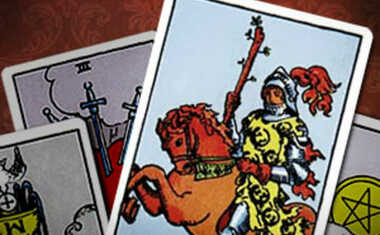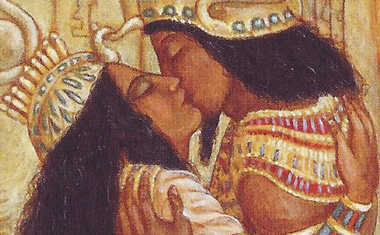
Papess Cards
The Iconology from 15/16th Century
The five surviving Papess images (card #4) are shown in Figure 1. All of the images show a seated woman wearing the triple papal tiara. Two have a staff topped with a cross, two have a bishop's crozier and the last holds a key, the key of Peter as a symbol of the papacy. Three have a closed book in their laps and one is reading from a book open on a reading stand. Two show a tonsured assistant as found on some Pope cards.
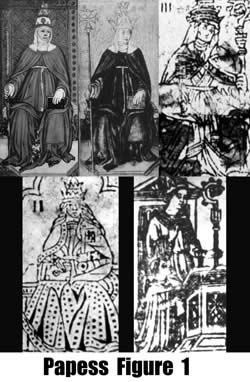 There are a number of candidates for the source of this symbol. The Papess may represent Isis who, surprisingly, was very much a part of Late Medieval thinking. Peter Comestor wrote an influential history of God's People in 1160 that discusses Isis as the inventor of letters and writing. This book was very popular and continued to be published into the 16th century. Isis also appears as a complete chapter in the History of Jacopo da Bergamo (1483). And we should not forget Plutarch's influential work: "Isis and Osiris". An image of Isis appears in the Appartmento Borgia in the Vatican (Figure 2). She is seated on athrone between two pillars with a veil stretched between them and a book in her lap. Figure 2 shows a distinct resemblance to the early Papess cards except that she does not wear a triple tiara. There is also a Renaissance image of Isis with the orb and horn crown (see Shumaker 1972 p. 247).
There are a number of candidates for the source of this symbol. The Papess may represent Isis who, surprisingly, was very much a part of Late Medieval thinking. Peter Comestor wrote an influential history of God's People in 1160 that discusses Isis as the inventor of letters and writing. This book was very popular and continued to be published into the 16th century. Isis also appears as a complete chapter in the History of Jacopo da Bergamo (1483). And we should not forget Plutarch's influential work: "Isis and Osiris". An image of Isis appears in the Appartmento Borgia in the Vatican (Figure 2). She is seated on athrone between two pillars with a veil stretched between them and a book in her lap. Figure 2 shows a distinct resemblance to the early Papess cards except that she does not wear a triple tiara. There is also a Renaissance image of Isis with the orb and horn crown (see Shumaker 1972 p. 247).
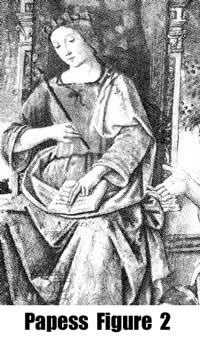
A second possibility is that the Papess represents Venus or a Priestess of Venus. There is a figure of the High Priestess of Venus in chapter 31 of Leon Battista Alberti's "Hypnerotomachia Poliphili" (1499). The image can be seen at The Electronic Hypnerotomachia.
As with the images of Isis, the image at this site resembles the early Papess cards but the priestess wears a bishop's mitre rather than the triple tiara.
The resemblance of the early Papess cards with Isis or Venus may be incidental. They are simply images of a female religious figure on a throne and, therefore, may not be the actual models for the Tarot figure. But even if these candidates are rejected, they do indicate that images of a goddess or High Priestess were part and parcel of the Renaissance imagination.
The religious tradition
If the woman on the early tarot cards is thought of as an actual person, rather than a symbol, then there are three possible candidates: Pope Joan, Manfreda or Mary.
Pope Joan was an Englishwoman who allegedly entered a monastic order disguised as a man. She rose in prominence and was elected pope, only to have her secret revealed when she collapsed in childbirth during a procession. The legend was quite popular during the time of the invention of the tarot, and persisted for centuries. For example, she appears among the historical popes in the 15th century Cathedral of Sienna. However, Pope Joan is ordinarily depicted in the act of giving birth or holding her baby. Pope Joan resources online include Commonplacebook.com and Pope Joan information.
The images of Pope Joan are mostly Post-Reformation and designed to ridicule the Papacy. Unlike the early Tarot cards, the images invariably show the infant. In addition, the early Tarot cards show no hints of ribaldry or ridicule that was associated with images of Pope Joan.
Another possibility is that the Papess represents Manfreda. Moakley (1966) has called attention to a small heretical sect, the Guglielmites, which was active in Milan about a century before the tarot cards were invented. They elected one of their members, Manfreda, as pope (Newman 1995)! Manfreda was a relation of the Visconti family who ruled Milan and commissioned the earliest surviving tarot cards. In that deck, the Papess is shown in the habit of the Umiliata, the order to which Manfreda belonged. However, beyond the deck specifically produced for the Visconti about 1450, the local Milanese phenomenon of Guglielmites is unlikely to be the source for the image on earlier decks, for example, the 1442 deck mentioned in an inventory of the Este estate in Ferrara.
Yet another possibility is that the image on the early Papess cards represents the Mother Mary. Figure 3 shows an image of Mary with a book in her lap and right hand raised. The robes and the veil around the sides of the head resemble the early Tarot images. However, her crown is not shown as a triple tiara.
It is also possible that the image on the early Tarot cards is not meant to represent an actual person but is an allegorical symbol, like the women on other cards such as the virtues. In this case, the Papess probably represents Mother Church.
Kaplan (1986 p.160) shows a reproduction of a painting by Vassari that celebrates the victory of Spain, Venice and the Church over the Turks. Here the Church is represented by a female Pope, such as pictured in the Glossary Of Medieval Architecture.
In most cases, the image of Mother Church is shown wearing a royal crown. And although the image is often shown holding a cross as on the early Tarot cards, she ordinarily also carries a chalice (e.g., Bynum 1995, plate 1).
The triumphal tradition
Petrarch's poem never mentions a papess and this card does not appear to be related to the traditional imagery associated with Petrarch. The only remote possibility is found in the Triumph of Chastity (line 246) where the procession is described as passing by the Sybil's dwelling place. As we will see below, a Sybil is another possible model for the Papess card.
The dance of death tradition
Since the Papess was not an estate of man and probably didn't represent an actual person, the image does not appear in the Dance of Death tradition.
The apocalyptic tradition
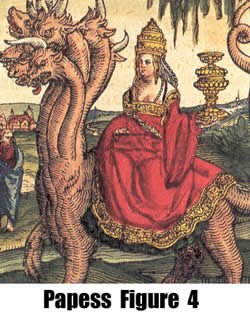 The apocalyptic tradition yields two candidates for the early Papess image. The first is the Whore of Babylon often shown with a papal tiara (Figure 4). With the triple crown and chalice this and similar images seem to identify the Whore with Mother Church. So Figure 4 may actually reinforce the hypothesis that the early Papess cards were meant to represent the Church.
The apocalyptic tradition yields two candidates for the early Papess image. The first is the Whore of Babylon often shown with a papal tiara (Figure 4). With the triple crown and chalice this and similar images seem to identify the Whore with Mother Church. So Figure 4 may actually reinforce the hypothesis that the early Papess cards were meant to represent the Church.
The early Papess image may also represent a Sibyl. The Sibyls were pagan prophets who were believed to have predicted the Virgin Birth and other aspects of Christianity. Although unfamiliar to us, the Sibyls (Figure 5) were an important part of late medieval culture because of the Sibylline Books, the earliest dating back to the 4th century. Cohn (1957, p. 33) points out that "...uncanonical and unorthodox though they were, the Sibyllines had enormous influence - indeed save for the Bible and the works of the Fathers they were probably the most influential writings known to medieval Europe. They often dominated the pronouncements of dominant figures in the Church, monks and nuns such as St. Bernard and St. Hildegard whose counsel even popes and emperors regarded as divinely inspired...From the fourteenth century onward translations began to appear in the various European languages...these books were being read and studied everywhere." Imagery derived from the books was widespread and therefore available to the card-player. Finiguerra's "Picture Chronicle" ~1460 contains 99 images representing history and includes the Sibyls. Phillippus de Barberiis' "Opuscula" (1481) has illustrations of the 12 Sibyls. The Sibyls were common illustrations in prayer books and Books of Hours.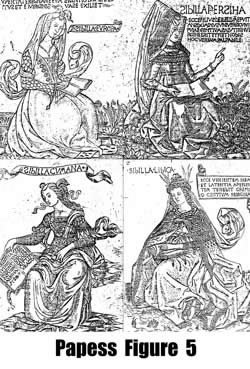
The Sibyls were also represented in publicly available art. They are found on French Cathedrals of the period. The church of San Francesco di Rimini (~1450) has images of Sibyls as does the Cambio of Perugia and the library of Pope Julius II in the Vatican. Sibylls are in the pavement of the Sienna Cathedral. They were probably a part of the original floor plan (~1400) and were executed ~1480. The easiest access to images of the Sibyls is in Levenson et al. (1973). There you will find, for example, the Sybil of Persia: seated, elaborate robe, book in her lap, face partially covered by a veil. An image of the Tiburtine Sibyl can be seen in Andre (1996 plate 58). The Cumean Sibyl (c1448) can be found standing with book in hand in Meiss (1970, p.149). Images of the Sibyls can also be found at Classical Mythology and the Sibyl Gallery.
Iconological analysis
An objective survey of the contemporary imagery yields a number of possibilities for the image on the early Papess card. Logically, the image is the female dual of the Pope, just as the Empress is the female dual of the Emperor. The logical dual of the celibate Pope is Mother Church. However, this simple logic does not necessarily exclude the other candidates.
The 15th century viewer might have simply seen the image as an allegorical female religious figure such as a Sibylline prophetess or even as a sorceress (Gurevich 1988). Images of the Sibyls were readily available in public places.
We must keep in mind that the 15th century viewer was familiar with the allegorical use of a female figure. So the image of the Papess does not necessarily imply that it represents an historical person. A popular drama, The Day of Judgment, is known from a mid-14th century manuscript (Emmerson 2000). The drama illustrates the common use of allegorical duals in the popular culture. Essentially every character in the drama has a dual. Thus, the Mother of Christ as Queen of Heaven is played against the mother of the antichrist represented by the apocryphal Whore of Babylon.
Interpretation
It is clear that the 15th century card-player was familiar with images of a variety of female religious figures. Therefore, the image of the Papess might have elicited a number of associations. The educated humanist might have thought of Isis or Venus. The court of Milan would likely have seen Manfreda.
The ordinary card-player might have associated the Papess with familiar images of Mother Church, Mother Mary, or a Sibyl. Depending on the amount of wine consumed during the game, one can easily envision a player drawing associations with Pope Joan or a witch.
But whatever the specific identification, one underlying interpretation seems to emerge: a dominant female figure of spiritual power. Thus, the occultists' transformation of the image into the High Priestess seems to be insightful. Within the 15th century Italian culture, duality was a common allegorical ploy. So the Papess may have been seen as a female dual of the Pope (e.g., Mary or Mother Church) or as an evil dual of the Pope (e.g., Whore of Babylon). But inescapably, any reasonable interpretation seems to necessitate two concepts: "female" and "spiritual power".

